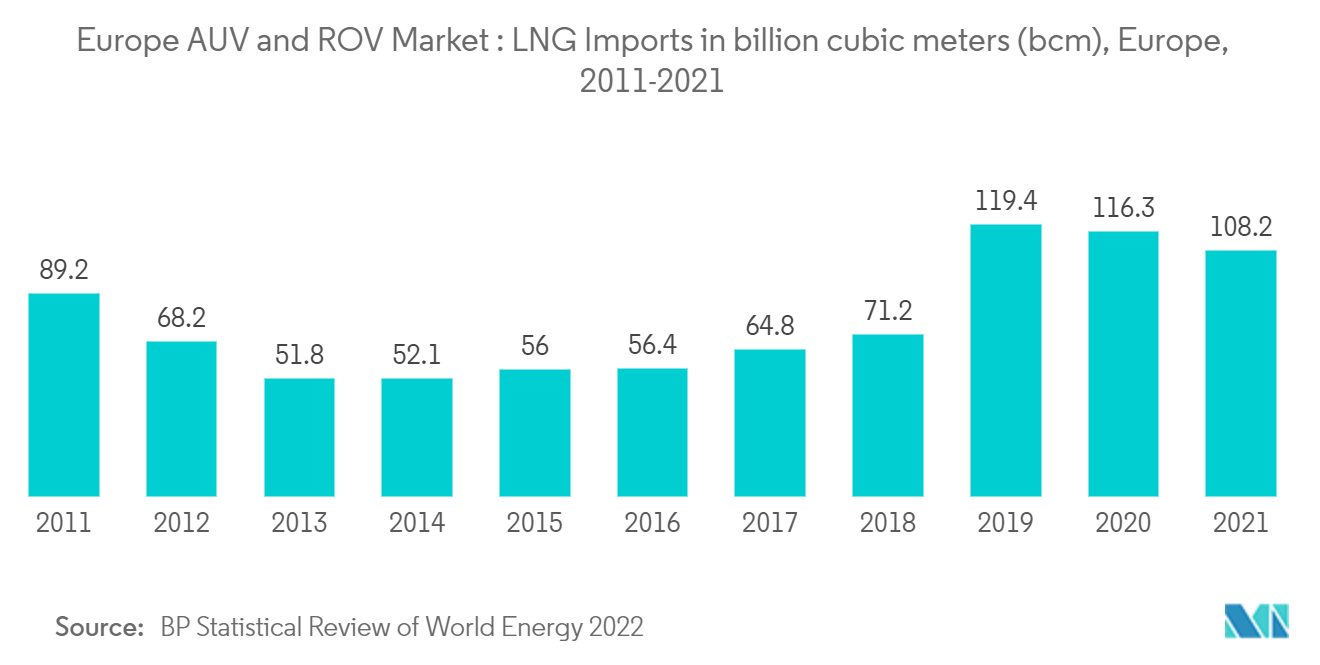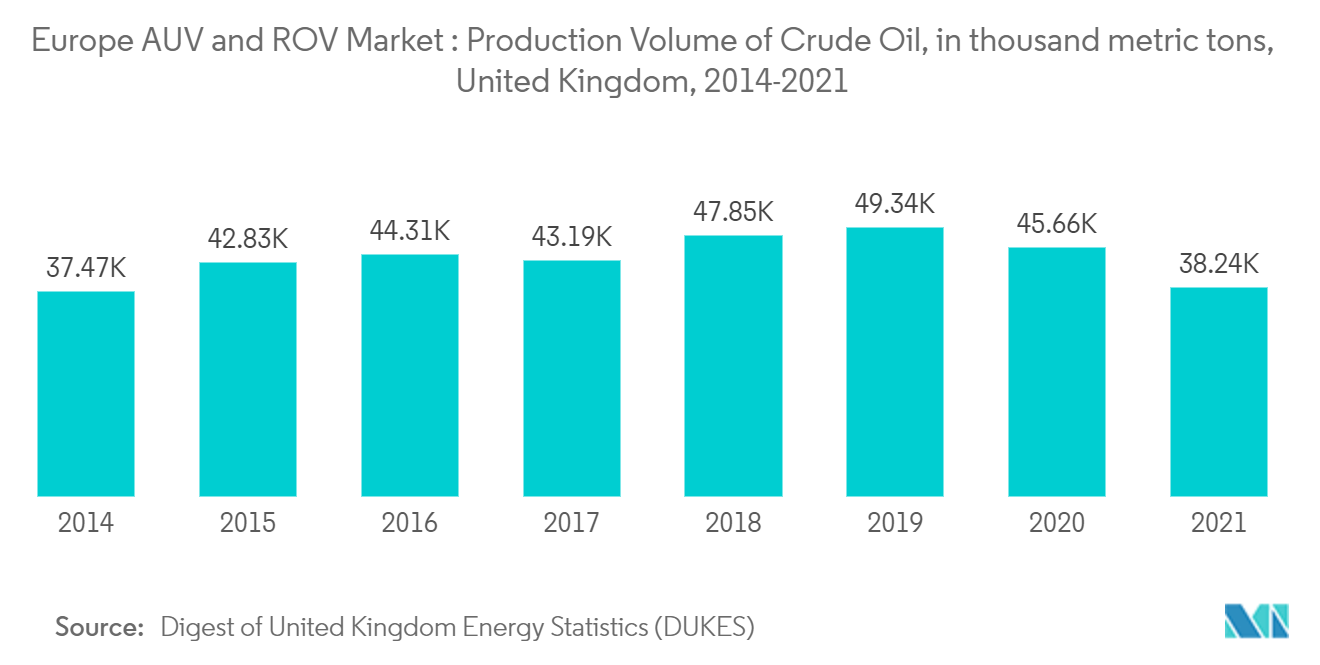Market Trends of Europe AUV and ROV Industry
This section covers the major market trends shaping the Europe AUV & ROV Market according to our research experts:
ROV Vehicle Type Expected to Witness Significant Growth
- Remotely-operated underwater vehicles (ROVs) are robots that complete functions underwater on behalf of a crew located on the surface, with whom the ROV is tethered. Some of the significant tasks of ROV include - equipment repair, scientific analysis, dredging/trenching, cable-laying, diver observation, platform inspection, pipeline inspection, surveys, drilling support, construction support, debris removal, call-out work, platform cleaning, subsea installations, telecommunications support, and object location and recovery.
- ROVs are incredibly complex and serve various sectors, such as search and rescue, military, aquaculture, recreation, discovery, oil and gas industry, offshore energy, submerged infrastructure, and shipping. Major factors driving the market studied include rising offshore oil and gas production activities, growing offshore wind power industry, and increasing offshore oil and gas decommissioning activities.
- Furthermore, ROV offers the advantage of being operated at extreme depths and can remain underwater for extended periods. Repeated tasks can be completed accurately and under harsh conditions that would hamper general driving conditions. Also, ROVs are less bulky compared to human-crewed vehicles and are relatively inexpensive.
- Oil and gas drilling activity in the Mediterranean Sea is relatively lower than in the North Sea. However, the marine activity in the region is dominated by trans-Mediterranean pipelines, LNG infrastructure, and large marine containers shipping goods to Europe. Due to this, oil and gas investments are relatively low. Despite these factors, some investments are being made in the hydrocarbon E&P sector. In February 2022, Reach Subsea won a contract to perform an ocean bottom node (OBN) campaign in the Mediterranean Sea, expecting to begin operations in 2022.
- Majority ROV contracts in the region are for the IRM service contracts for the trans-continental pipeline supplying gas from North Africa to Europe. Gas producers in North Africa, such as Algeria and Morocco, have also increased their LNG export capacities. Countries on the Mediterranean coast in Europe are also investing in LNG handling infrastructure.
- Since Russia's invasion of Ukraine in February 2022, most European countries have placed economic sanctions on the country and want to find a viable alternative to Russian energy imports. Additionally, as the EU has pledged to achieve significant environmental targets by reducing carbon emissions, natural gas remains the main component of the Energy Transition strategy of most European nations. Due to this, the import capabilities of Southern European Nations along the Mediterranean coast, such as Italy, Spain, and the Balkans, are critical to the energy security of mainland Europe. For instance, LNG imports from the European region have increased significantly from 56 billion cubic meters (bcm) in 2015 to about 108.2 bcm in 2021.
- To reduce the consumption of Russian gas and increase import capacity, the German government instructed utilities RWE and Uniper to rent 3 Floating Storage and Regasification Units (FSRUs) from the Greek company Dynagas and the Norwegian Hoegh. As Floating Storage and Regasification Units (FRSUs) are often former supertankers repurposed to regasify significant quantities of LNG, they need significantly less investment and construction time. They only require a deep sea port for operation. The increased demand for LNG imports mandates the increased use of offshore ROV services for inspection, which is expected to drive the market during the forecast period.
- Therefore, based on the above-mentioned factors, the ROV vehicle type is expected to witness significant demand in the European AUV and ROV market during the forecast period.

United Kingdom to Witness Significant Demand
- To reduce the dependence on the import of natural gas and crude oil, especially from Russia, the North Sea production and exploration activities are expected to increase in the United Kingdom. Further, according to the Digest of United Kingdom Energy Statistics, crude oil production volume has increased significantly from 37,474 thousand metric tons in 2014 to about 38,239 thousand metric tons in 2021.
- Amid the energy crisis in the country, the United Kingdom's Committee on Climate Change has reported that due to the escalating natural gas prices and threat to long-term energy insecurity, it would not object to issuing new licenses for further oil and gas exploration in the North Sea. It will be one of the primary drivers for the AUV and ROV market.
- As most fields in the North Sea are mature, and many fields have either reached or are about to reach their decommissioning phase, the demand for decommissioning services remains high. As marine decommissioning is a challenging and dangerous operation for human divers, the demand for offshore AUVs and ROVs remains high.
- For instance, in December 2021, Maersk Supply Service (MSS) won a decommissioning contract from Neptune Energy for the Juliet field in the United Kingdom's North Sea marine territory. The contract's primary operation included removing piping spools and umbilicals using the utility ROV services system (UTROV), a remotely-operated tool carrier equipped with multiple attachments for the recovery of subsea equipment. The demand from the decommissioning market is expected to be a significant driving factor for the market during the forecast period.
- Therefore, based on the above-mentioned factors, United Kingdom is expected to witness significant demand for the AUV and ROV market in European region during the forecast period.


